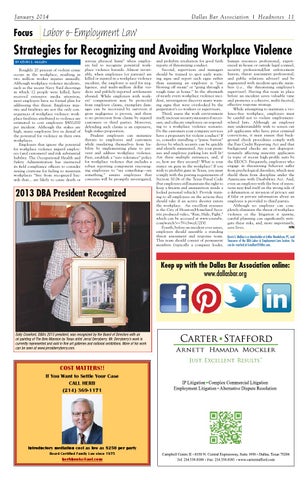J anu a ry 2 0 1 4
Focus
Dal l as Bar A ssoci ati on l Headnotes 11
Labor & Employment Law
Strategies for Recognizing and Avoiding Workplace Violence by Kevin S. Mullen
Roughly 20 percent of violent crime occurs in the workplace, resulting in two million worker injuries annually. Although workplace violence incidents, such as the recent Navy Yard shootings in which 12 people were killed, have received extensive media attention, most employers have no formal plan for addressing this threat. Employee injuries and fatalities are not the only consequences of workplace violence: workplace fatalities attributed to violence are estimated to cost employers $800,000 per incident. Although the stakes are high, many employers live in denial of the potential for violence in their own workplaces. Employers that ignore the potential for workplace violence imperil employees (and customers) and risk substantial liability. The Occupational Health and Safety Administration has instructed its field compliance officers to consider issuing citations for failing to maintain workplaces “free from recognized hazards that... are likely to cause death or
serious physical harm” when employers fail to recognize potential workplace violence hazards. Almost invariably, when employees (or patrons) are killed or injured in a workplace violence incident, the employer is sued for negligence, and multi-million dollar verdicts and publicly-reported settlements abound. While employers with workers’ compensation may be protected from employee claims, exemplary damages can be recovered by survivors if gross negligence is proven, and there is no protection from claims by injured customers or third parties. Moreover, defending such claims is an expensive, high stakes proposition. Prudent employers can minimize threats to employees and customers while insulating themselves from liability by implementing plans to prevent and address workplace violence. First, establish a “zero tolerance” policy for workplace violence that includes a robust reporting component encouraging employees to “see something—say something,” assures employees that concerns will be promptly investigated,
2013 DBA President Recognized
and prohibits retaliation for good faith reports of threatening conduct. Second, supervisors and managers should be trained to spot early warning signs and report such signs rather than assuming an employee is “just blowing off steam” or “going through a tough time at home.” In the aftermath of nearly every workplace violence incident, investigators discover many warning signs that were overlooked by the perpetrator’s co-workers or supervisors. Third, assess the work environment itself, increase security measures if necessary, and educate employees on responding to a workplace violence scenario. Do the customers your company services have a propensity for violent conduct? If so, consider installing a “panic button” device by which security can be quickly and silently summoned. Are your premises and employee parking lots well lit? Are there multiple entrances, and, if so, how are they secured? What is your stance on guns in the workplace? If you wish to prohibit guns in Texas, you must comply with the posting requirements of Section 30.06 of the Texas Penal Code (but employees still maintain the right to keep a firearm and ammunition inside a locked personal vehicle). Provide training to all employees on the actions they should take if an active shooter enters the workplace. An excellent resource is the City of Houston/Homeland Security produced video, “Run, Hide, Fight,” which can be accessed at www.youtube. com/watch?v=5VcSwejU2D0. Fourth, before an incident ever arises, employers should assemble a standing threat assessment and response team. This team should consist of permanent members (typically a company leader,
human resources professional, experienced in-house or outside legal counsel, security professional/law enforcement liaison, threat assessment professional, and public relations advisor) and be augmented with incident-specific members (i.e., the threatening employee’s supervisor). Having this team in place before an incident saves valuable time and promotes a cohesive, multi-faceted, effective response strategy. While attempting to maintain a violence-free workplace, employers must be careful not to violate employmentrelated laws. Although an employer may understandably wish to screen out job applicants who have prior criminal convictions, it must ensure that background check procedures comply with the Fair Credit Reporting Act and that background checks are not disproportionately affecting minority applicants (a topic of recent high-profile suits by the EEOC). Frequently, employees who engage in threatening behavior suffer from psychological disorders, which may shield them from discipline under the Americans with Disabilities Act. And, even an employer with the best of intentions may find itself on the wrong side of a defamation or invasion of privacy suit if false or private information about an employee is provided to third parties. Although no employer can completely eliminate the threat of workplace violence or the litigation it spawns, careful planning can significantly mitigate these risks, and, more importantly, HN save lives. Kevin S. Mullen is a shareholder at Littler Mendelson, PC, and Treasurer of the DBA Labor & Employment Law Section. He can be reached at kmullen@littler.com.
Keep up with the Dallas Bar Association online: www.dallasbar.org
Sally Crawford, DBA’s 2013 president, was recognized by the Board of Directors with an oil painting of The Belo Mansion by Texas artist Jerral Derryberry. Mr. Derryberry’s work is currently represented and sold in fine art galleries and national exhibitions. More of his work can be seen at www.jerralderryberry.com.
COST MATTERS!! If You Want to Settle Your Case CALL HERB (214) 369-1171
Introductory mediation cost as low as $250 per party Board Certified Family Law since 1975
herbhooks@aol.com
